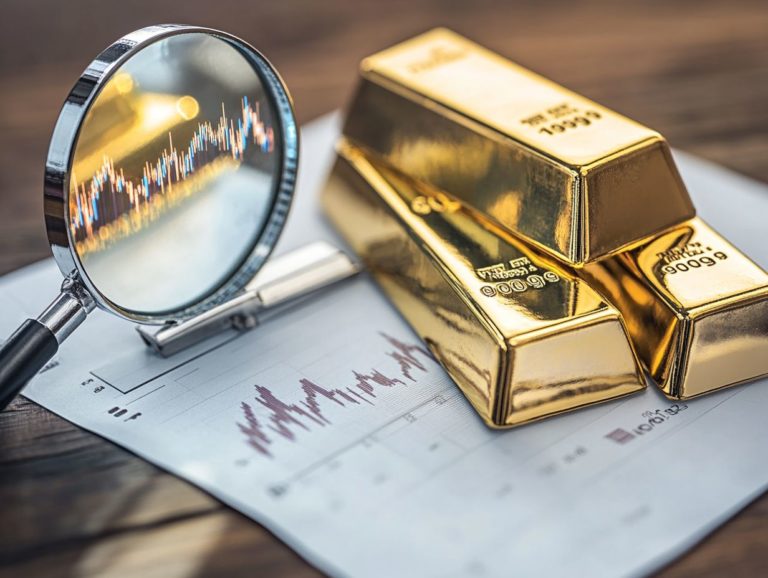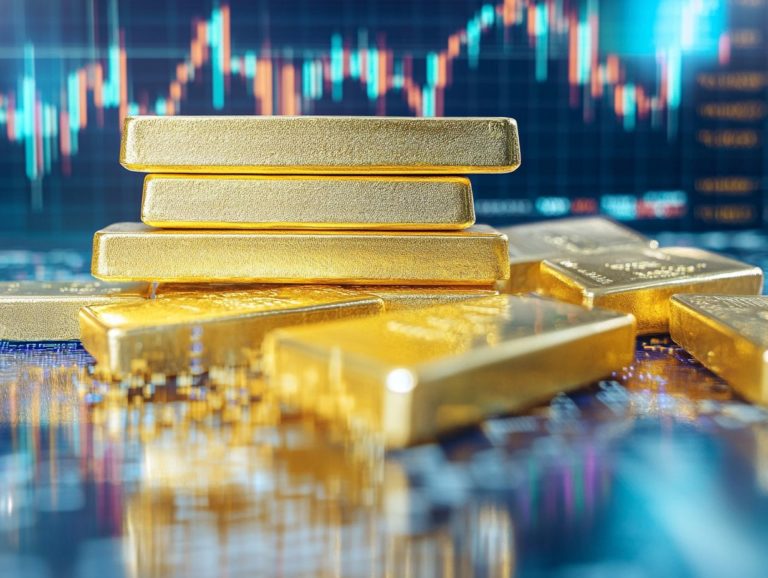Platinum Demand: Industrial vs. Investment
Platinum, frequently eclipsed by gold and silver, occupies a distinctive niche in the realm of precious metals. Its rarity, coupled with exceptional properties, renders it an attractive investment and a vital element in numerous industrial applications.
This exploration delves into the diverse demand for platinum, scrutinizing its industrial uses, investment avenues, and the global dynamics that sway its value. Whether you re intrigued by its technological applications or contemplating its addition to your investment portfolio, grasping the demand for platinum is essential now more than ever.
Contents
- Key Takeaways:
- Understanding Platinum Demand
- Industrial Uses of Platinum
- Investment Demand for Platinum
- Factors Impacting Platinum Demand
- Frequently Asked Questions
- What is the difference between industrial and investment demand for platinum?
- What industries drive the demand for platinum in the industrial sector?
- How does the demand for platinum in industrial applications affect its price?
- What factors influence investment demand for platinum?
- Is industrial or investment demand the main driver of the platinum market?
- How has the balance between industrial and investment demand for platinum changed over time?
Key Takeaways:
- Platinum is a rare and valuable metal with various industrial uses and investment potential.
- Industrial demand for platinum is driven by its unique properties and applications in industries such as automotive and jewelry.
- Investment demand for platinum is influenced by factors such as economic trends and comparison with other precious metals.
Understanding Platinum Demand
Understanding platinum demand is crucial, as it spans multiple market segments, including automotive needs, industrial applications, and investment interests among precious metals.
Global platinum demand has experienced significant fluctuations, shaped by various factors such as emission regulations and the surge of electric vehicles.
Shifting market dynamics driven by investment opportunities also play a role.
The World Platinum Investment Council plays a key role in analyzing these trends and forecasting total platinum demand, particularly highlighting its catalytic properties, which help convert harmful gases into less harmful ones, aligning with stringent environmental standards.
What is Platinum and Why is it Valuable?
Platinum is a precious metal celebrated for its exceptional catalytic properties and high value, making it a highly sought-after commodity for both investment and industrial applications.
Its rarity drives up its market price, as platinum is significantly scarcer than gold. This limited supply, paired with robust demand across various sectors particularly in the automotive industry where it s essential for catalytic converters enhances its desirability. Catalytic converters are devices in cars that help reduce harmful emissions.
With its lustrous finish and remarkable durability, platinum also stands out in the jewelry market, further amplifying its appeal. Together, these attributes not only spur investment interest but also create a complex interplay of factors that significantly influence its value on the global stage.
Industrial Uses of Platinum
Platinum boasts remarkable versatility across a multitude of industries. Its exceptional durability and unique catalytic properties render it critical in sectors such as automotive, healthcare, and energy.
Applications in Various Industries
In the automotive sector, platinum plays a vital role in catalytic converters, which are essential for reducing harmful emissions and adhering to stringent environmental regulations. This amazing metal transforms toxic gases into cleaner air!
In the glass manufacturing industry, platinum serves as a crucial component in high-temperature crucibles that enable the production of top-quality glass products.
In the medical field, platinum’s unique properties shine through as it s utilized in various treatments, including specific chemotherapy drugs, thanks to its remarkable ability to target cancer cells effectively.
The diverse applications of platinum truly highlight its invaluable contributions across these different sectors.
Factors Affecting Demand
The demand for platinum is shaped by several pivotal factors, including the car industry’s needs due to emission rules and trends in precious metal investments.
As the automotive industry shifts towards electric vehicles, the demand for traditional catalytic converters often containing platinum is transforming. New regulations aimed at reducing carbon emissions are accelerating this change.
Manufacturers are now exploring alternative technologies. Investor interest in precious metals continues to influence market dynamics.
Recycling practices are gaining prominence as well. These practices play a crucial role in both supply and sustainability efforts, impacting the availability and pricing of this invaluable resource.
Investment Demand for Platinum
Investment demand for platinum has grown remarkably. Savvy investors look to diversify their portfolios with precious metals.
This includes options like platinum ETFs and various other investment products. These cater to a discerning clientele.
Investment Options and Trends
Investment options for platinum include platinum ETFs, bars, and coins. These products are tailored for both individual and institutional investors eager to gain exposure to precious metals.
These avenues present a tangible asset to hold and contribute to a diversified portfolio. This effectively mitigates risks associated with volatile markets.
Recognizing the historical stability and potential for price appreciation in platinum is essential. Trends such as increasing industrial demand and limited mining supplies generate significant interest.
Conducting thorough market analysis is essential. It equips you to navigate fluctuations in investment performance and assess market sentiment.
By understanding these dynamics, you empower yourself to make informed decisions regarding your entry points and potential returns.
Comparison with Other Precious Metals
When comparing platinum with other precious metals like palladium, consider the distinctions in demand trends, price volatility, and industrial applications. These factors significantly influence your investment decisions.
Platinum sets itself apart due to its unique characteristics and diverse utility. This is particularly evident in the automotive and jewelry sectors.
While palladium may have recently piqued investor interest with skyrocketing prices, the broader industrial demand for platinum driven by its critical role in catalytic converters and electronics often lends stability to its market performance.
The dynamics of supply and demand, shaped by mining output and recycling rates, create appealing opportunities for potential investors. Understanding these nuances is crucial for anyone considering investments in precious metals.
Factors Impacting Platinum Demand
Factors influencing platinum demand are multifaceted. They are shaped by economic trends, global market dynamics, and an increasing focus on environmental sustainability.
Economic and Global Trends
Economic trends in key markets like China, the US, and Japan profoundly impact platinum demand. These trends influence global supply and pricing dynamics.
As these nations experience fluctuations in industrial production, the need for platinum especially in the automotive and electronics sectors grows increasingly significant.
When consumer confidence surges, it often leads to a rise in luxury purchases featuring this precious metal. This further amplifies its demand.
Investment trends in platinum are shaped by shifts in market sentiment and the appeal of safe-haven assets during economic uncertainties. These introduce another layer of complexity to its pricing.
These interconnected factors highlight the crucial role of economic conditions in defining the platinum landscape in today s markets.
In conclusion, understanding the factors affecting platinum investment is vital. This knowledge can lead to successful investment strategies that maximize returns.
Environmental Factors
Environmental factors impact the demand for platinum in the automotive sector.
Stringent emission regulations and the rise of electric vehicles are key drivers.
Automakers are under increasing pressure to reduce their environmental impact. This shift has spurred a robust adoption of hybrid and electric models.
As a result, there’s a greater emphasis on sustainable technologies. These can sometimes reduce reliance on platinum for catalytic converters.
However, platinum holds significant value because it plays a crucial role in catalytic processes for conventional vehicles.
It also has emerging applications in fuel cells. Understanding the intricate relationship between regulatory frameworks and technological advancements is essential for anyone in the industry.
Frequently Asked Questions
What is the difference between industrial and investment demand for platinum?
Industrial demand is when platinum is used for manufacturing and production. Investment demand is when people buy platinum as a financial asset.
What industries drive the demand for platinum in the industrial sector?
The main industries include automotive, chemical, and petroleum. These sectors value platinum for its high resistance to heat and corrosion.
How does the demand for platinum in industrial applications affect its price?
The demand for platinum in industrial applications significantly impacts its price. It is a major factor in determining the balance of supply and demand in the market.
What factors influence investment demand for platinum?
Investment demand for platinum is influenced by economic conditions, geopolitical events, and investor sentiment towards precious metals.
Is industrial or investment demand the main driver of the platinum market?
Both industrial and investment demands are significant. However, industrial demand is typically the primary driver due to its consistent nature.
How has the balance between industrial and investment demand for platinum changed over time?
In recent years, investment demand for platinum has steadily increased. More investors are diversifying their portfolios with precious metals, shifting the balance between industrial and investment demand.













